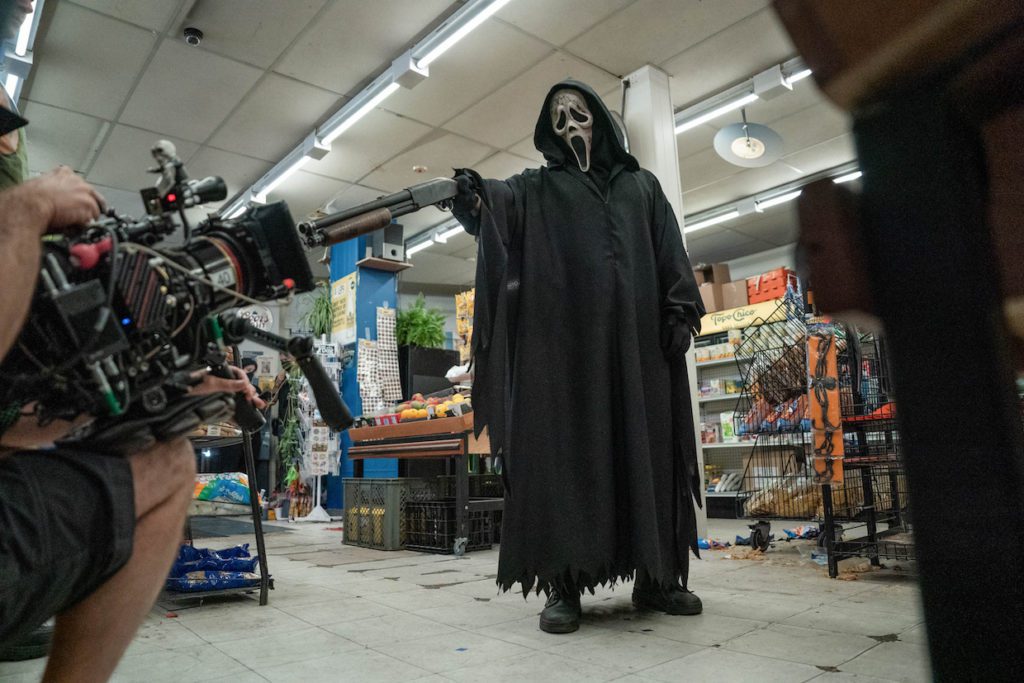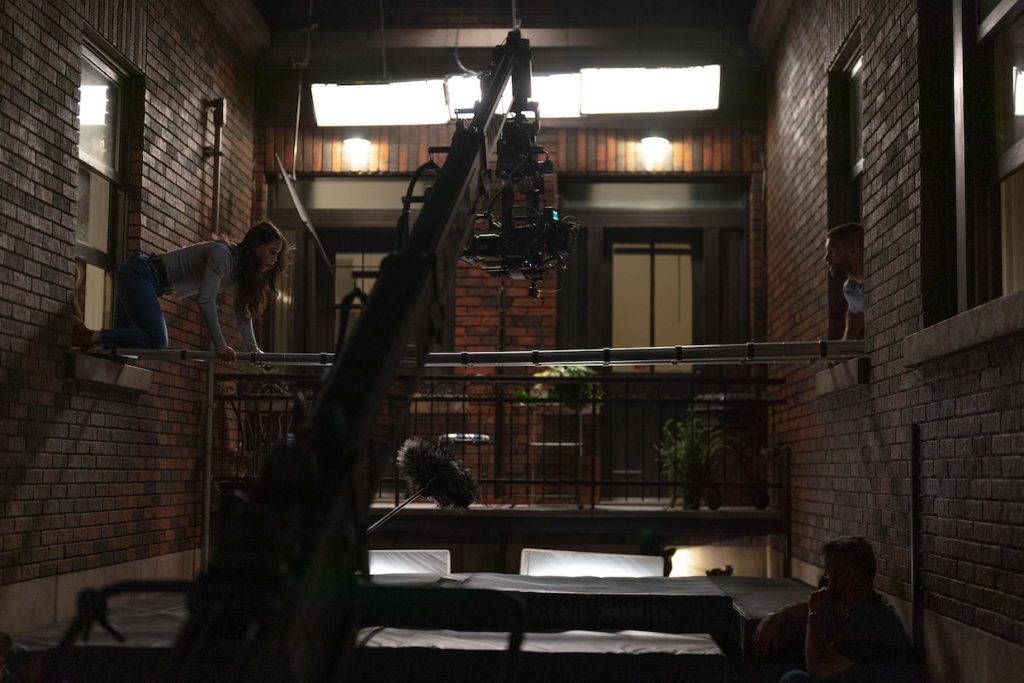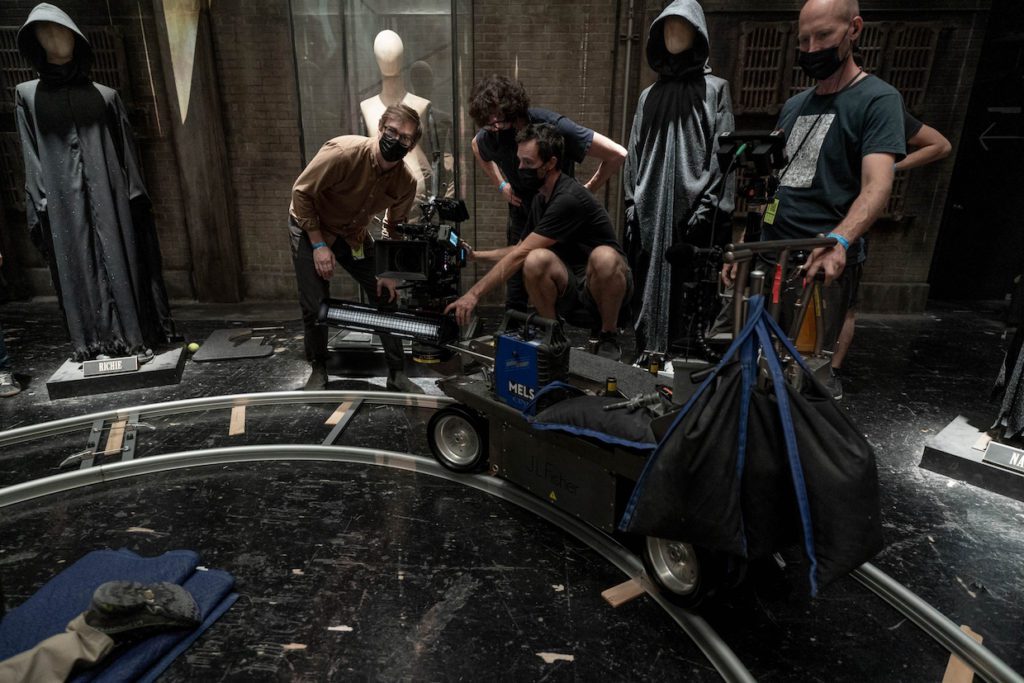 Back to selection
Back to selection
Shutter Angles
Conversations with DPs, directors and below-the-line crew by Matt Mulcahey
Ghostface Takes Brooklyn: DP Brett Jutkiewicz on Scream VI
 Scream VI
Scream VI In 1989, Friday the 13th transplanted its hockey-masked slasher from summer camp to concrete jungle for the franchise’s eighth installment, Jason Takes Manhattan. That titular promise was not fully delivered upon: Manhattan was mostly Vancouver and Jason spent much of the running time on a boat full of high schoolers traveling to the city. The newest Scream offers up a similar relocation as Ghostface follows the previous chapter’s survivors from Woodsboro to college. Again, a Canadian city (this time Montreal) stands in for New York. But this time, the killer actually spends the entire running time chasing his victims through bodegas, subway cars and unaffordable apartments.
With Scream VI out in theaters, cinematographer Brett Jutkiewicz spoke to Filmmaker about bringing Ghostface to the Big Apple and shifting the series to spherical lenses for the first time.
Filmmaker: In the opening scene a character watches Friday the 13th Part VIII: Jason Takes Manhattan, a nod to another slasher franchise that took its killer to New York City. You’re a New Yorker who’s shot a lot of films there. What’s the key to believably playing Montreal as New York?
Jutkiewicz: When I first read the script, I was excited that the story was taking place in New York. I thought it was a great shift for the franchise to go somewhere new and somewhere as iconic as New York City. Then I found out we were shooting in Montreal, and it started my head spinning. Being a New Yorker, it was super important to me to represent New York in Montreal as best I could. It started with thinking about New York streets at night and how the lighting feels to me. So much of the movie takes place at night, so for the night exteriors it was really important to me to match that vibe. Even if we weren’t necessarily going to have streets that looked exactly like Brooklyn, where a lot of our locations are supposed to be, at least I could try to create a mood and a feeling that’s evocative of New York through the color of the streetlights, the amount of light and shadow and just keeping it feeling dark and gritty. A lot of that is also Michele Laliberte, our production designer, and her team bringing in all the elements—street signs and subway entrances and things—that really helped tell that story. Location scouting was also important. We scoured the city for places that could have the feeling of the neighborhood that the sisters [played by Melissa Barrera and Jenna Ortega] are supposed to be living in, which is South Brooklyn-ish.
Filmmaker: I read an interview with the film’s screenwriters where they talked about how you protested during the subway scene because the lights in New York subway cars don’t flicker that much. Did you become sort of the arbiter of what passed as authentically New York?
Jutkiewicz: Yeah, I think I was in a way. I got teased about it quite a bit. “Oh, the New Yorker is going to tell us what it’s like.” [laughs] But for that subway train flicker effect, I definitely said to the directors, “Is that too much? It’s not totally realistic that it would flicker that much.” And they were like, “No, we love it. It works.” And I think that’s the whole thing about this film: we’re creating this heightened naturalism where, even if something isn’t super true to reality, we wanted it to be true enough to make you feel like you are in these environments while we heighten the experience and lean into the tension and the emotional experience the characters are going through. But we did want it to feel real and maybe a little bit more raw and gritty than the previous film.
Filmmaker: What’s unique about the Scream series compared to other slasher franchises is that, while the killer’s costume remains similar, it’s a different person underneath in every film. This is your second movie in the series. How do you approach the way you light and frame Ghostface or the way the character moves from film to film?
Jutkiewicz: What’s interesting about Ghostface is that once the character is in the costume, they kind of cease to be themselves and just become Ghostface. We talked a lot about that. Ghostface really is always Ghostface regardless of who’s in the costume.
Filmmaker: So, there’s a sense of continuity regardless of who is under the robe and behind the mask?
Jutkiewicz: There is. A lot of the lessons I learned on the previous film carried over in terms of how to approach shooting Ghostface. What was interesting for this film is that the mask is different. It’s much more aged and textured than the cleaner, whiter, glossier mask [from the previous film]. In prep I did a lot of testing to figure out which angles of light made the mask look good, and I found often that a light coming up from below really brought out the texture of the mask and gave it an extra creepy quality. So, we mainly tried to light the mask either coming from below or coming off axis from the side to rake the mask rather than hitting it flat on from the front.

Filmmaker: Along with the subway scene, the sequence in the bodega with Ghostface and the sisters places the film firmly in an urban environment compared to Woodsboro.
Jutkiewicz: That was a practical location. For that scene, I wanted to create as much freedom for the movement of the actors as possible. I worked with our art department and my gaffer, Eames Gagnon, and his team, who rigged Astera tubs into the fixtures in the ceiling. They were controlled by the board operator so we could dim them and change their color however we wanted throughout the course of the scene. We also put our tubes in the refrigerators. It’s a fairly brightly lit space and that really fits with the scene, because Ghostface is so brazen and so aggressive and just doesn’t care that he’s in a room full of other people. We brought some small units in here and there for eye lights—for example, when the sisters are crawling around on the ground—but for the most part, it was just embracing the fluorescents, then turning some lights off in the background if we needed to take down walls and create a little more shape.

Filmmaker: Let’s circle back to the subway scene. It’s Halloween, so the subway car is filled with people in iconic horror costumes, including multiple Ghostface masks. More and more DPs are using LED screens for scenes like that. How did you approach creating the illusion of a moving subway car on stage?
Jutkiewicz: That was probably the sequence we talked about the most in prep, just because of the logistical challenges. We talked about LED panels outside of the cars, but we would’ve needed so many of them to cover a 50-foot subway car. Then we started talking about other options and I thought we might be able to pull it off with just a lighting effect with chase lights. We did a test with a cardboard cutout of the subway car with windows cut into it and it looked pretty good, so we developed that idea further. We wound up putting about 70 feet of lights on each side of the train car—the 50-foot length of the car, plus 10 feet on either end. There were three rows of lights outside the train at different heights on either side and we programmed a chase sequence that would have a feeling of randomness, so it didn’t feel super repetitive. I also hung some very thin black silk between the windows and lights, which basically just diffused the lights slightly and obscured the actual fixtures. The art department scuffed up the windows as well [to limit visibility out of them]. Basically, it was just a big black box with massive lighting rigs on either side of it.
Inside, we had the flicker effect. I was able to cue that live over the walkie talkie to the board operator, so we could watch what the actors were doing and flicker the lights at the right time, keep them off for as long as we wanted and have them come back on at the right time. I can’t imagine doing it any other way now because of the amount of control that I had in the sequence. When I was standing on that set, watching the lights go by with the special effects team rocking it back and forth, even to my eye it felt like I was standing on a moving subway car in New York.
Filmmaker: So, you didn’t even put greenscreen out the window? You achieved the effect entirely with lighting?
Jutkiewicz: There was no green screen at all. The special effects team was actually able to tow the car into and out of our subway platform set. So, there’s some brief moments when you can see the car stopping at a station. That’s actually practical. It’s being pulled from a black fabric tunnel onto our subway platform set and you can actually see it pulling in. That was also a big discussion in the beginning. How are we going to see the train move in and out of the platform without having a moving train? It was a team effort to figure that all out, but I think it worked well, especially when Mindy [played by Jasmin Savoy Brown] gets separated from the group. Being able to actually tow that train out of the shot and not have to cheat it with different angles or only be able to see in one direction when that happens was great.
Filmmaker: The subway platform was a set as well? I assumed that the train work was done on stage, but the platform was a practical location.
Jutkiewicz: No, they built the platform as well, then re-dressed it to be different stops along the route. I don’t know exactly what you would call it, but they had a little pallet mover kind of vehicle that hooked onto the subway car and could tow it in and out of the set.

Filmmaker: I always enjoy a good “crawling between two buildings on a ladder” scene. Was that a mixture of practical location and stage work?
Jutkiewicz: Yeah. Anything wide or overhead was done on the real location, then the art department built a matching set on stage. On the set, the actors were probably 10 feet off the ground with big mats stacked underneath. Getting the overhead shots on location was a challenge. We had to get a construction crane just to lift the camera crane onto the roof and to take it down. We talked about doing greenscreen for the overhead shots looking down, but we it was going to feel much more real to do it on the practical location. And kudos to [directors] Matt Bettinelli-Olpin and Tyler Gillett for helping push that through. That’s kind of their ethos: If we can do it practically, we should. Then, on stage, our approach was to avoid doing impossible angles. We thought of it as, “If we were going to shoot this all on location, where could we actually put the camera?” That was our starting place. We didn’t want a camera that’s floating in the middle of nowhere.
Filmmaker: What camera and lenses did you use?
Jutkiewicz: We used the Alexa Mini and shot on Cooke S5 lenses. This is the first Scream to be shot spherical. That was an idea that I had early on reading the script and something I pitched to Matt and Tyler. I think anamorphic lenses are beautiful. As cinematographers, we love them for their texture and imperfections and the way that they render things, but I thought it might be an interesting choice for this one—because of the new environment—to use spherical because they strip away a little bit of that layer of artifice. It’s just a little truer to how the eye sees things. We shot tests and showed them as a blind test to the directors and they wound up really liking these Cookes, which we had actually used together before on Ready or Not.
Filmmaker: We’ve now talked for Ready or Not, The Black Phone and two Screams, all of which were shot on the Alexa Mini. With the Alexa LF and now the Alexa 35, it seems like the Mini may not be used as frequently going forward. Do you think you’ll be hopping to a different camera soon?
Jutkiewicz: I’ve heard great things about the Alexa 35. I haven’t used it yet, but I’m definitely interested in testing it. The Mini is a great camera and for this movie—with the lenses that we wanted to use and for other practical reasons—it just made sense. But yeah, I do have a feeling that the Alexa 35 is going to be kind of the go-to if you want a Super35-sized sensor.
Filmmaker: I’m assuming it’s a result of the Avatar sequel being in theaters, but there was a 3D option when I saw Scream. Did you consider that at all during the shoot or have much input on the conversion?
Jutkiewicz: There might have been some discussions either while we were shooting or in prep that they were thinking about it, but it was not a sure thing at all when we were shooting. So, I really just approached it like I would any other film. In terms of the conversion, I really wasn’t involved in that. Not that I was kept out of it, but I just wasn’t around to be there to oversee it. I think the technology has progressed so much for the conversion in the last 10 years or so that it’s quite good now, but that wasn’t something I was conscious of while we were shooting.

Filmmaker: Let’s finish up with the movie theater location. Some Stab fanatics have erected a Ghostface museum with all the costumes from the different films in display cases, highlighted by beams of light.
Jutkiewicz: That was a really fun set. I believe we used tungsten Lekos for that hanging on the rafters, with a little bit of smoke in the air so you feel the shafts of light. We wanted those lights to be cooler than the rest of the space just for some color contrast, so we gelled them as well. Matt, Tyler and I talked about whether it stretched the realm of believability that whoever set up that museum would’ve lit it essentially like a professional and spent time hanging lights from the rafters. They felt that it was okay for that space to feel heightened and a little bit surreal. The idea of the movie being projected on the screen at that location actually came later. Once we found that theater location, the writers, Guy [Busick] and James [Vanderbilt], came to Montreal to look at the space and started to fashion the story around it, which was amazing to be able to put those ideas into the script.
